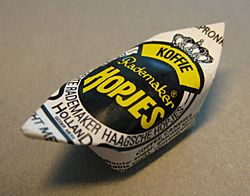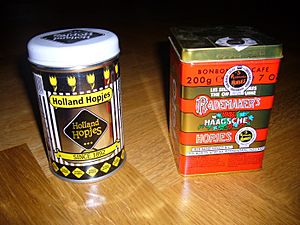Hopje facts for kids
 |
|
| Alternative names | Haagsche Hopjes |
|---|---|
| Place of origin | Netherlands |
| Main ingredients | Coffee, caramel, cream, butter |
Hopjes (/ˈhɒpjəs/), also known as Haagsche Hopjes, are a special type of Dutch candy. They taste a little like coffee and caramel. These tasty treats first appeared way back in the 1700s. They are famous for not getting sticky or soft over time.
How Hopjes Were Invented
The story of the hopje candy begins with a man named Baron Hendrik Hop. He was a special representative, called an "envoy," for the Netherlands. In 1792, he had to leave his job in Brussels because French soldiers invaded Belgium.
Baron Hop then moved to The Hague in the Netherlands. He lived above a candy shop owned by a man named Theodorus van Haaren. Baron Hop really loved coffee. One night, he left his coffee, sugar, and cream on a heater. The liquid evaporated, leaving behind a solid, tasty substance. He tried it and loved the new flavor.
His doctor told him to stop drinking coffee. So, Baron Hop asked the candy maker, Mr. Van Haaren, to create some "lumps of coffee" for him. After trying different ideas, Van Haaren made a candy from coffee, caramel, cream, and butter.
The Candy Becomes Famous
Baron Hop was very excited about his new candies. He offered them to all his guests, and everyone loved them. Soon, the "Hopjes" became very popular. Mr. Van Haaren's candy shop even started getting orders for hopjes from other countries.
The "Real" Hopjes Dispute
A company called J.P. Rademaker started making their own version of hopjes. They claimed their candies were "the only real Haagsche Hopjes." Rademaker was also the first to wrap each candy in its own printed paper. This was a new idea at the time.
This led to a long disagreement between Rademaker and Van Haaren's company, Nieuwerkerk. They argued for many years about who made the "real" hopjes. In 1949, the Rademaker company from Rotterdam bought Nieuwerkerk. But the argument continued between different parts of the Rademaker company for 40 more years!
Finally, in 1989, a special committee decided that Rademaker could not use the phrase "the only real Haagsche Hopjes." Now, Rademaker Hopjes wrappers say "Alleen Echt Met Dit Merk." This means "Only Real With This Brand" in Dutch. Since 1999, Rademaker has been owned by RBV Leaf, which is part of the CSM group.
See also
 In Spanish: Hopje para niños
In Spanish: Hopje para niños


